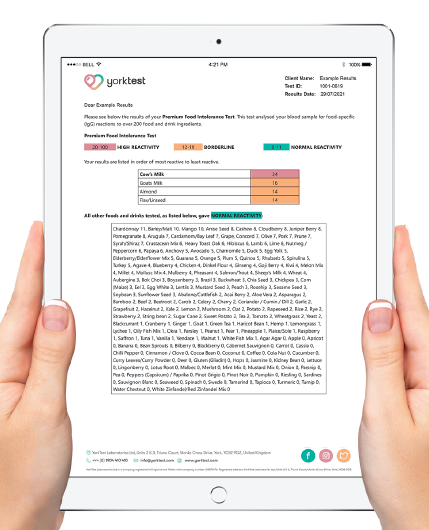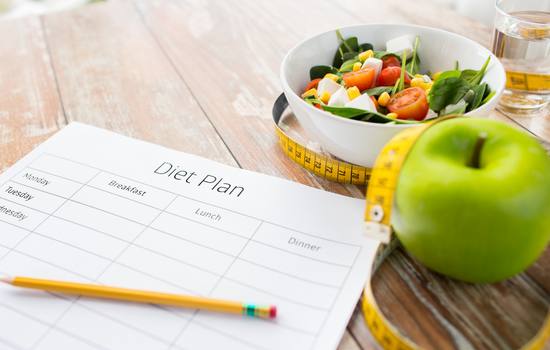Your Guide Book
Diet has a huge impact on your health and by choosing to have a food intolerance test you have made the first step in discovering what could be contributing to your symptoms. As well as your results, part of the process will be is to keep a daily food and drinks diary. This will help monitor aspects of your lifestyle that relate to your health. There could be other factors apart from the reaction to hidden ingredients that could be making your condition worse.
How to understand the results
The list of food and drink intolerances are listed in order starting with High Reactivity, then Borderline, then Normal Reactivity. Here is an explanation of what each category means.
The list of food and drink intolerances are listed in order starting with High Reactivity, then Borderline, then Normal Reactivity. Here is an explanation of what each category means.
High Reactivity
Indicates raised IgG antibody levels to these food or drink ingredient(s) and you should try to eliminate them completely from your diet.
Borderline
Indicates a borderline reaction to these food and drink ingredient(s) and you may benefit by limiting their consumption.
Normal Reactivity
These ingredients can in general be eaten without restriction, unless you already know that they cause a reaction and you have been avoiding them, in which case you should continue to do so.
Your results are provided with a numerical value in descending order of reactivity. You can use all of these values to prioritise the foods that you may want to include or remove in your new diet.

Step One – Preparation
Planning and preparation is essential when embarking on your new elimination diet. As the saying goes “fail to prepare, prepare to fail!”
The best way to ensure success is to be organised so you need to draw up a plan of action.
Conduct research on the internet, visit local supermarkets and health food stores to discover new items and brands. Stock up your cupboards with everything that you can eat and drink, that way you will avoid temptation. Think about how you are going to manage your diet at work and with your family. It is a good idea to work out a weekly menu plan incorporating new recipes and ideas. Make sure that you plan for any upcoming events such as meals out, parties and holidays.
Your diet must provide you with a full range of essential nutrients, so for help on planning your diet read this guidebook. Don’t forget to look at labels carefully to help you identify all the ingredients. Remember, if you need support our team of specialists are always on hand.
When we have sent you your results via e-mail, we will also send you the contact number of our nutritionist.
Our nutritionist is happy to chat with you for a free 30 minute consultation. Please come with a prepared list of questions to ensure you get the most out of your free consultation. If you need further help with menu planning then you can book more consultations with the nutritionist, these are chargeable. The cost will depend on how many consultations you require.
N.B the advice given is not intended to replace any recommendations offered by your Doctor or Healthcare Practitioner, as they will have full details of your medical history.
 • Get organised by drawing up an action plan
• Get organised by drawing up an action plan
• Give yourself a few days to research alternative foods and drinks
• Work out some basic menus and recipes
• Don’t worry if the results seem daunting, you can do it!
Step Two – Starting your new diet

Now you are ready to start so pick a date and go for it!
Remember to use the diary enclosed in the results pack so that you can keep assessing your progress and tweak anything that doesn’t appear to be working for you.
If you don’t initially achieve your targets don’t give up but keep trying. You will keep discovering what does work and what doesn’t work for you and your chances of success will keep rising.
The main thing is to be realistic and accept that things don’t always run to plan. The diary is there to help you get on track, help deal with any difficulties, but mainly to mark your progress.
If you don’t initially achieve your targets don’t give up but keep trying.
What to expect from your new diet
You may be lucky enough to achieve good results immediately. On average, 3 out of 4 people feel better after acting on the results of YorkTest Food Intolerance Programmes, the majority within 3 weeks.
Some people may feel worse for the first few days, this is likely to be withdrawal symptoms – if this continues it is important to seek medical advice. Symptoms of withdrawal can include fatigue and mood swings – but once you have adjusted to your diet you should be back to normal.
Some of our customers find that they notice a change in weight or body shape; this is not a cause for concern! You will find your overall health improving and that you have an increased amount of energy.
If you have any concerns about any physical changes speak to your Doctor or Healthcare Practitioner.

 Tips
Tips
• Always check ingredient labels – if in doubt, don’t eat or drink it
• Get as much advice as possible
• Do not go without meals or fluids
• Drink plenty of water
• Vary your diet as much as possible
• Be strict, it is the only way you know it will work
• It may not be forever – many people are able to reintroduce foods and drinks eventually
• Go for basic ingredients that are not processed or refined
• Make sure you speak to one of our Nutritional Therapists who can advise on how to keep your elimination diet nutritious – This is extremely important
Reintroducing high reactivity foods
We recognise that many people wish to start re-introducing foods into their diet following the exclusion processes. This means that you do not eat foods on your ‘high reactivity list’ for 3 months. This must be done with care and it is important to start slowly. At a time convenient to your individual needs, introduce one food at a time and leave one week between that food and the next. If there are no symptoms after a few days then use that food on a four day or more rotation to maintain increased tolerance.
If at any time your symptoms start to return or you start to feel ill DO NOT continue with the re-introduction of that food.
